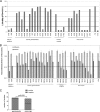Differential phenotypic diversity among epidemic-spanning Salmonella enterica serovar enteritidis isolates from humans or animals
- PMID: 20802078
- PMCID: PMC2953042
- DOI: 10.1128/AEM.00497-10
Differential phenotypic diversity among epidemic-spanning Salmonella enterica serovar enteritidis isolates from humans or animals
Abstract
Nontyphoidal salmonellae are major causes of food-borne disease worldwide. In Uruguay, Salmonella enterica serovar Enteritidis was the most commonly isolated serovar throughout the last decade, with a marked epidemic period between 1995 and 2004. In a previous study, we conducted comparative genomics of 29 epidemic-spanning S. Enteritidis field isolates, and here we evaluated the pathogenic potential of the same set of isolates using several phenotypic assays. The sample included 15 isolates from human gastroenteritis, 5 from invasive disease, and 9 from nonhuman sources. Contrary to the genetic homogeneity previously observed, we found great phenotypic variability among these isolates. One-third of them were defective in at least one assay, namely, 10 isolates were defective in motility, 8 in invasion of Caco-2 cells, and 10 in survival in egg albumen. Twelve isolates were tested for invasiveness in 3-day-old chickens, and five of these were significantly less invasive than the reference strain. The two oldest preepidemic isolates were reduced in fitness in all assays, providing a plausible explanation for the previous negligible incidence of S. Enteritidis in Uruguay and supporting the view that the introduction or emergence of a more virulent strain was responsible for the marked rise of this serovar. Further, we found differences in fitness among the isolates which depended on the source of isolation. A total of 1 out of 14 isolates from human gastroenteritis, but 6 out of 13 isolates from other sources, was impaired in at least two assays, suggesting enhanced fitness among strains able to cause intestinal disease in humans.
Figures




Similar articles
-
Naturally occurring motility-defective mutants of Salmonella enterica serovar Enteritidis isolated preferentially from nonhuman rather than human sources.Appl Environ Microbiol. 2011 Nov;77(21):7740-8. doi: 10.1128/AEM.05318-11. Epub 2011 Sep 16. Appl Environ Microbiol. 2011. PMID: 21926214 Free PMC article.
-
Cell invasion of poultry-associated Salmonella enterica serovar Enteritidis isolates is associated with pathogenicity, motility and proteins secreted by the type III secretion system.Microbiology (Reading). 2011 May;157(Pt 5):1428-1445. doi: 10.1099/mic.0.044461-0. Epub 2011 Feb 3. Microbiology (Reading). 2011. PMID: 21292746 Free PMC article.
-
Genomic and phenotypic variation in epidemic-spanning Salmonella enterica serovar Enteritidis isolates.BMC Microbiol. 2009 Nov 18;9:237. doi: 10.1186/1471-2180-9-237. BMC Microbiol. 2009. PMID: 19922635 Free PMC article.
-
The chicken, the egg and Salmonella enteritidis.Environ Microbiol. 2001 Jul;3(7):421-30. doi: 10.1046/j.1462-2920.2001.00213.x. Environ Microbiol. 2001. PMID: 11553232 Review.
-
Epidemiology and control of egg-associated Salmonella enteritidis in the United States of America.Rev Sci Tech. 1997 Aug;16(2):542-53. doi: 10.20506/rst.16.2.1045. Rev Sci Tech. 1997. PMID: 9501367 Review.
Cited by
-
The combined effect of stressful factors (temperature and pH) on the expression of biofilm, stress, and virulence genes in Salmonella enterica ser. Enteritidis and Typhimurium.Arch Microbiol. 2021 Sep;203(7):4475-4484. doi: 10.1007/s00203-021-02435-y. Epub 2021 Jun 17. Arch Microbiol. 2021. PMID: 34137898
-
RNA sequencing reveals differences between the global transcriptomes of Salmonella enterica serovar enteritidis strains with high and low pathogenicities.Appl Environ Microbiol. 2014 Feb;80(3):896-906. doi: 10.1128/AEM.02740-13. Epub 2013 Nov 22. Appl Environ Microbiol. 2014. PMID: 24271167 Free PMC article.
-
Pathogenicity of Salmonella strains isolated from egg shells and the layer farm environment in australia.Appl Environ Microbiol. 2015 Jan;81(1):405-14. doi: 10.1128/AEM.02931-14. Epub 2014 Oct 31. Appl Environ Microbiol. 2015. PMID: 25362057 Free PMC article.
-
Signature-tagged mutagenesis screening revealed a novel smooth-to-rough transition determinant of Salmonella enterica serovar Enteritidis.BMC Microbiol. 2017 Mar 3;17(1):48. doi: 10.1186/s12866-017-0951-4. BMC Microbiol. 2017. PMID: 28253852 Free PMC article.
-
The vertical transmission of Salmonella Enteritidis in a One-Health context.One Health. 2022 Dec 5;16:100469. doi: 10.1016/j.onehlt.2022.100469. eCollection 2023 Jun. One Health. 2022. PMID: 36507074 Free PMC article. Review.
References
-
- Anderle, P., M. Rumbo, F. Sierro, R. Mansourian, P. Michetti, M. A. Roberts, and J. P. Kraehenbuhl. 2005. Novel markers of the human follicle-associated epithelium identified by genomic profiling and microdissection. Gastroenterology 129:321-327. - PubMed
-
- Barrow, P. A. 1991. Experimental infection of chickens with Salmonella enteritidis. Avian Pathol. 20:145-153. - PubMed
-
- Bäumler, A. J., B. M. Hargis, and R. M. Tsolis. 2000. Tracing the origins of Salmonella outbreaks. Science 287:50-52. - PubMed
-
- Betancor, L., F. Schelotto, A. Martínez, M. Pereira, G. Algorta, M. A. Rodríguez, R. Vignoli, and J. A. Chabalgoity. 2004. Random amplified polymorphic DNA and phenotyping analysis of Salmonella enterica serovar Enteritidis isolates collected from humans and poultry in Uruguay from 1995 to 2002. J. Clin. Microbiol. 42:1155-1162. - PMC - PubMed
-
- Betancor, L., L. Yim, M. Fookes, A. Martinez, N. R. Thomson, A. Ivens, S. Peters, C. Bryant, G. Algorta, S. Kariuki, F. Schelotto, D. Maskell, G. Dougan, and J. A. Chabalgoity. 2009. Genomic and phenotypic variation in epidemic-spanning Salmonella enterica serovar Enteritidis isolates. BMC Microbiol. 9:237. - PMC - PubMed
Publication types
MeSH terms
Grants and funding
LinkOut - more resources
Full Text Sources
Medical

